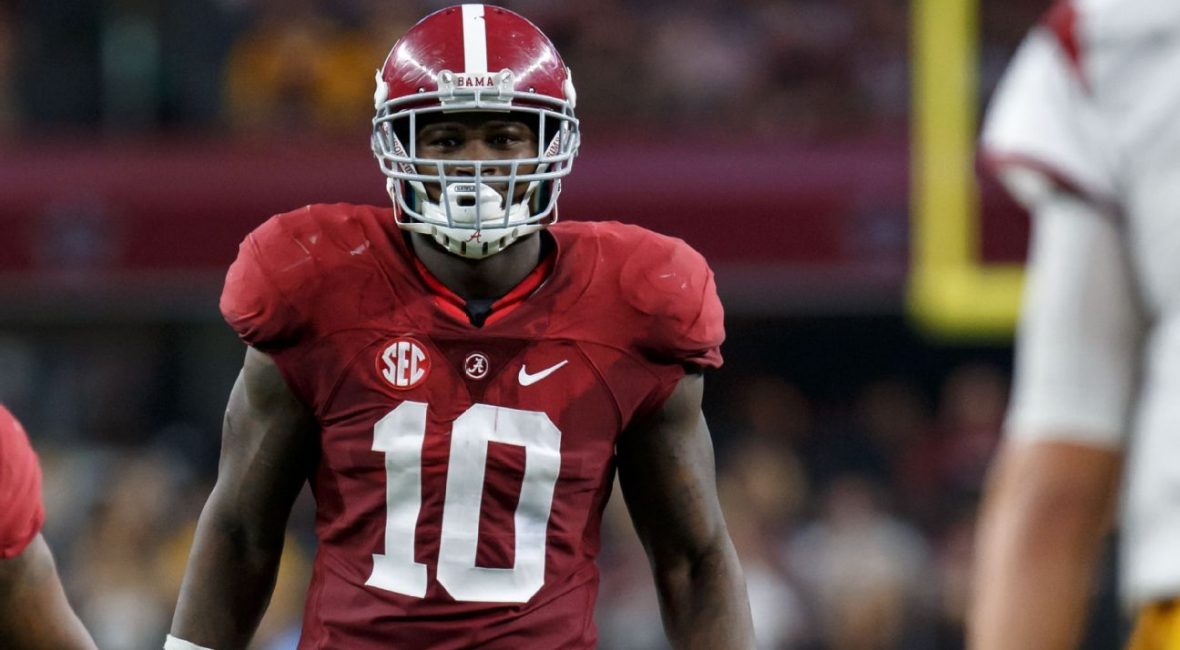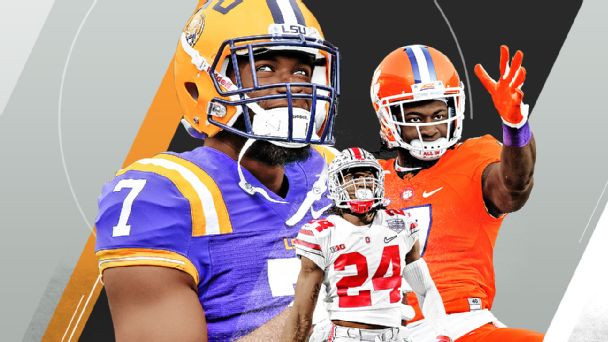Former Alabama linebacker Reuben Foster, a potential top-10 pick in next month’s NFL draft, was sent home from the Indianapolis scouting combine for a “heated altercation” he got into Friday with a hospital worker, according to multiple sources.
All one NFL spokesman would say was that Foster was being sent home for “personal reasons.” He did not want to comment further.
Foster, the top-graded inside linebacker for many teams, was scheduled to go through team interviews Friday night and testing Saturday, none of which will happen now, according to sources. Foster was scheduled to fly home to Tuscaloosa, Alabama, on Saturday.
NFL officials are reviewing the procedures that contributed to the incident to see if they can make improvements and ensure it doesn’t happen again, per league sources.
Another league source said there was a “miscommunication” that allowed the argument between Foster and a hospital worker to escalate.
Foster had been waiting for an extended period for what the NFL calls his “pre-exam,” when he grew increasingly impatient and began questioning a hospital worker.
The hospital worker did not take kindly to Foster’s words, and eventually the two were face-to-face, in a heated exchange.
Other players were there at the time, and the NFL is questioning them to get a full account of events.
But one league source said the league has to review the procedures and create better communication so that players understand what is happening and why there are delays.
According to AL.com, Foster said “nothing happened” in a live Instagram video posted Saturday.
“Y’all, stop asking me what happened, for real,” Foster said in the video, according to AL.com. “Nothing happened.”
Foster said teammates were with him at the time of the incident and could verify what happened.
“I’m chilling with my people right now,” Foster said in the video. “My agent backs me. I’m staying low. When I get my chance, I’m taking advantage of it. I’m telling you. That’s all I know.”
When asked about Foster on Saturday, his former teammate Jonathan Allen said he didn’t know what had happened but called the situation “surprising” and “disappointing.”
Tim Williams, a defensive end who was at the Indiana University Health Methodist Hospital at the same time, said he was in a different group and couldn’t say exactly what happened.
“We were all waiting for our names to be called. He was with the linebackers and I was with all of the D-line,” Williams said. “I was in a different room.”
Foster is a potential top-10 pick, and one team executive said last night that he thought “Foster was a legitimate top-three pick” coming into the combine.
Foster is recovering from recent rotator cuff surgery in his right shoulder and was not scheduled to participate in drills at the combine. In his video chat, Foster said he’d be out of the sling in a week.
“Everything ain’t perfect,” he said. “I’m good. I just have to think. I just had to sit back and relax and think about what I really want.”
Foster’s projected recovery timetable was about four months, a source told ESPN’s Adam Caplan, which is well ahead of the start of training camps in July.
Foster was Alabama’s leading tackler last season and a unanimous first-team All-American. He also won the Butkus Award, given to the nation’s best linebacker.
Information from ESPN’s Jeff Legwold and The Associated Press was used in this report.
Here’s how some of the top performers at running back, a position of need for the Tampa Bay Buccaneers, did in their workouts at the NFL Scouting Combine this week. This includes how their talents stack up and how the Bucs could use them:
Dalvin Cook, Florida State: His 4.49 40-yard dash was the seventh-fastest among running backs, and he posted a 30.5-inch vertical leap. At 5-foot-10, 210 pounds, he’s got the size and physicality to be a feature back at the next level and could be plugged into Doug Martin’s spot without much trouble. He’s an electrifying playmaker and can catch the ball well. His 759 yards after contact last season were most in college football. Ball security will be an issue — he logged 16 fumbles in three seasons. He also said that he needs to improve in pass protection, a natural deficiency for a lot of backs coming out of college. He said it would be a “dream come true” to reunite with Jameis Winston down in Tampa.
Leonard Fournette, LSU: Should fans be concerned that he posted a poor 28.5-inch vertical? No, unless he plans to hurdle defenders (he’s better served running through them) or dunk on a goal post, although it is a drill that measures explosiveness in the lower body. He ran a 4.52 in his 40 — at 240 pounds, that is very impressive. He came very close to Cook and Christian McCaffrey’s times despite being more than 30 pounds heavier. He has the build and running style to be fed the ball 30 times a game, which is critical in setting of play-action for the Bucs. He can certainly run between the tackles, averaging 7.06 yards per carry on inside runs in 2016. His 162.8 rushing yards per game in 2016 led the FBS. He did have an ankle injury last season but said it’s 100 percent now.
Kareem Hunt, Toledo: Hunt’s 36.5-inch vertical was fifth-highest among running backs but he disappointed in the 40, running a 4.66 after hoping to run under 4.50. He looks very similar to Martin on tape. He’s not a burner, but has good pad level, hits the hole hard and keeps his wheels moving. He’s patient and does a great job of seeing a tiny hole and turning it into a big run. The Bucs love explosive plays, which are defined as runs of 12-plus yards. Hunt had 37 of them in 2016, tied for eighth in college football. His 113 explosives over the last four years were second in that span. He averaged 123.6 yards per game over the last three seasons. The Bucs have met with him.
Alvin Kamara, Tennessee: Kamara gained a lot from his combine workout. He posted a 4.56 40, 14th among running backs, and a 39.5-inch vertical, the highest at the position. After his workout, he turned heads in receiving drills — he’s got great hands, which you can see on his college tape. At 5-10 and 214 pounds, he could become an every-down back but rarely touched the ball more than 20 times in a game, spending much of his time as a backup to Jalen Hurd. Can he be a workhorse? His versatility is a plus. He can catch passes out of the backfield, line up wide, and play special teams. On tape, he looks more like a guy who would operate best in space, contributing in the short passing game and getting to the perimeter, but he averaged 6.35 yards per rush on inside runs last season. A true one-cut runner. He’s an energetic runner, but how powerful is he?
Marlon Mack, South Florida: Mack posted a 4.50 40, ninth among running backs, along with a 35.5 vertical (eighth) and a 10.5-inch broad jump (fourth). He shattered every rushing record at USF, averaging 6.69 yards per carry in three seasons and 100.3 yards per game in that span. Defenders never caught him from behind. He’s has great patience and vision waiting for holes to develop, shows great balance in staying on his feet and has cutting ability to make defenders miss. Body-type-wise he looks to be more of a complementary back at the next level versus a workhorse despite his heavy workload in college. He can do a lot more than just run the ball — he can be a pass-catcher, too. He has had conversations with the Bucs and, along with Hunt, is a great example of the value this draft has at the position.
NFL draft home page »
• 2017 NFL draft order »
• Mel Kiper Jr.: Mock 2.0 »
• Todd McShay’s Top 32
• McShay: Top prospects by position
• Todd McShay: Mock 2.0 »
• Mel Kiper Jr.’s Big Board »
• Mel Kiper Jr.: Top 10 by position »
• Pro day schedule for prospects »
• Underclassmen who have declared »
• NFL draft player rankings »
Christian McCaffrey, Stanford: McCaffrey posted a 4.48 in the 40, fourth-fastest at the position, a 37.5-inch vertical (tied for second). He had an 11.03 in the 60-yard shuttle, the best among all running backs, so he redeemed himself from a poor showing in the bench press (10 reps). In drills, he looked explosive and changed directions seamlessly. He’s a polished route runner with soft hands that can be used in the passing game, hence why he also worked out as a receiver. His skill-set far exceeds that of a traditional running back, and the Bucs shouldn’t use him that way. This is an ‘X’ factor type of player who Koetter could run inside (he’s better off-tackle though), and use as a scatback, slot receiver, out wide, and as a punt returner and kick returner.
Samaje Perine, Oklahoma: He’s the other back from Oklahoma, the one not named Joe Mixon. He had people talking after he put up 30 reps on the bench press, the most of all running backs. At 5-10 and 233 pounds, he ran a 4.66, which isn’t very fast (keep in mind, Fournette ran a 4.51 at 240) but he’s a bruising, downhill runner and can handle short-yardage situations. He does run with stiff hips. It should be noted that he was also used as a blocker for Mixon, the more-famous OU back, so he could handle some fullback responsibilities at the next level. The Bucs don’t have a fullback on their roster currently (tight end Luke Stocker is the team’s best run-blocking tight end).






 Round 1: April 27, 8 p.m. ET
Round 1: April 27, 8 p.m. ET